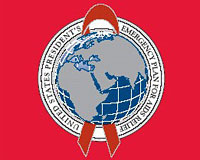| HIV Counseling and Testing (Updated February 2008) PDF version PDF version
 |
President George W. Bush's
Emergency Plan for AIDS
Relief is the largest commitment
ever by any nation for an
international health
initiative dedicated to
a single disease-- a
five-year, $15 billion,
comprehensive approach to
combating the disease
around the world.
U.S. Department of
State
U.S. Agency for
International
Development
U.S. Department of
Defense
U.S. Department of
Commerce
U.S. Department of
Labor
U.S. Department of
Health and Human
Services
Peace Corps
Mailing address:
SA-29, 2nd Floor
2201 C Street, NW
Washington, DC 20522-2920
www.PEPFAR.gov
| |

HIV Counseling and Testing
The U.S. President’s Emergency Plan for AIDS Relief (Emergency Plan/PEPFAR) supports efforts of host nations to dramatically expand HIV counseling and testing services. PEPFAR supports HIV counseling and testing, where consent is obtained and testing is performed in accordance with international standards. Within these standards, countries use a range of services to meet their specific needs. Client-initiated or self-referred counseling and testing is requested by an individual. In a medical setting, provider-initiated counseling and testing occurs when health care workers recommend an HIV test and the patient chooses to accept.
|
The Power of Partnerships:
- As of September 30, 2007, men, women and children benefited from over 33 million HIV counseling and testing sessions since the inception of the Emergency Plan.
- Through September 30, 2007, the Emergency Plan supported training or retraining of 112,800 individuals to provide counseling and testing.
|
There is also increasing international support for "routine" or "opt-out" testing, where all patients are counseled and tested unless they decline. Routine testing occurs in select health care settings, such as pre-natal clinics or medical wards with high prevalence of HIV, Tuberculosis, or sexually transmitted infections. This approach has successfully identified many patients in need of treatment and care.
The Emergency Plan’s priorities for HIV counseling and testing include:
- Counseling and testing in clinical settings – With the availability of antiretroviral and opportunistic infection treatment, there is an urgent need to ensure that people who are ill with HIV-related symptoms are tested for HIV.
- Access to counseling and testing for the general population – Every person who wants to know his or her status should have access to services, particularly in countries with high HIV prevalence.
- Couple counseling and testing to identify discordant couples – Once they learn they are HIV-discordant, couples can adopt preventive behaviors to reduce the chances of HIV transmission to the negative partner.
- Promotion of all forms of HIV counseling and testing – Professional advertising campaigns have proved highly effective in increasing demand for counseling and testing services and reducing stigma associated with testing.
- Linking counseling and testing to other HIV services – Functioning referral systems are essential to ensure that clients are linked to prevention, treatment and care services.
- Expansion of rapid test kit technology – Rapid testing is essential for testing conducted outside of health facilities. Finger-prick (whole blood) and oral rapid testing does not require cold chain storage or additional equipment and supplies, allowing health care workers to test in a variety of settings.
|
|

The Emergency Plan at Work
An estimated 33 million people worldwide are living with HIV/AIDS, yet it is estimated that less than 20 percent of them know they are HIV-positive. The expansion of services to help individuals, couples and families learn their HIV status is a cornerstone to the provision of HIV prevention, treatment and care services.
The Emergency Plan sponsors a range of activities, including support for counseling and testing sites, training, country and program assessment, test kit procurement, promotion activities, quality assurance, and monitoring and evaluation. The following examples illustrate how the Emergency Plan works in partnership with host nations to support HIV counseling and testing:
- In Kenya, mobile counseling and testing is being expanded throughout the country to the general population and youth as well as to special populations, including nomads, the hearing-impaired, prisoners, and wildlife wardens and their families.
- In Uganda, community health workers are being trained to visit the homes of antiretroviral treatment patients. Workers offer home-based HIV counseling and testing services to household members. The program links HIV-positive family members to treatment and care programs and delivers prevention interventions to HIV discordant couples.
- In Vietnam, the Emergency Plan supports the development of national guidelines for voluntary counseling and testing, and the implementation of outreach activities to encourage counseling and testing for most-at-risk populations, such as injecting drug users, people engaged in prostitution, and men who have sex with men.
- In Nigeria, counseling and testing in medical settings has been rapidly scaled-up. At some sites, nurses trained in counseling and testing are posted in medical wards to perform HIV tests for patients and their family members. Some partner organizations have experienced a tenfold increase in the numbers of people tested, allowing health care workers to identify HIV-positive patients who may be eligible for antiretroviral treatment.
- In Rwanda, the Rwanda Defense Force provides counseling and testing services to military members. The majority of soldiers in the Rwandan military are deployed in hard-to-reach areas with minimal access to HIV counseling and testing and treatment services. In response, an integrated mobile counseling and testing unit and a mobile video unit, travel to each of the Defense Force’s 12 brigades.
|
|
Resources:
The U.S. Government has developed numerous tools to facilitate the implementation of HIV counseling and testing programs, including:
- Couple HIV Counseling and Testing Training Curriculum and Protocol;
- Routine Testing and Counseling in Clinical Settings Training Curriculum and Protocol;
- HIV Rapid Testing Training Package;
- CDC's Revised Recommendations for HIV Testing of Adults, Adolescents, and Pregnant Women in Health-Care Settings [in the United States].
These materials are available online at http://www.cdc.gov/gap.
World Health Organization Guidance on provider-initiated HIV testing and counseling in health facilities is available online at http://www.who.int/hiv/topics/vct/en/index.html.
|
|
| |  |  |




 PDF version
PDF version